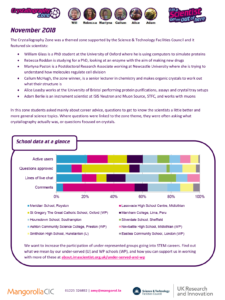Dubnium Zone Report – March 2019
 Click to read.[/caption]
Click to read.[/caption]
The Dubnium Zone was a general science zone supported by the Science & Technology Facilities Council. In the zone were six scientists:
- Tori Blakeman, who informs the public about the science innovation happening at STFC.
- itus Mutwiri, who teaches at the Kenya Methodist University and does research for the International Livestock Research Institute.
- Stuart Higgins, the zone winner and whose research group uses Diamond Light Source, is trying to understand how stem cells ‘feel’ and how those cells change.
- Hannah Dalgleish, who studies star clusters to gain clues about how the galaxy formed and how stars evolve and whose research institute is funded by STFC.
- Gill Harrison, who teaches obstetrics, abdominal and gynaecology ultrasound.
- Alessandro Novellino, who works at the British Geological Survey.




